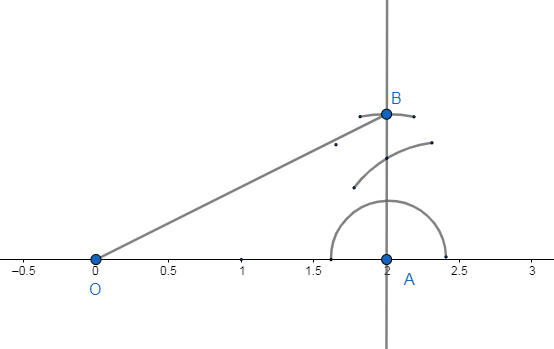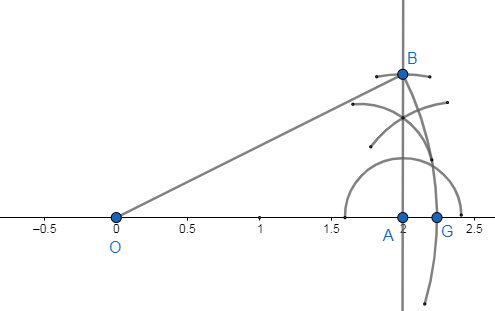
Show how $\sqrt{5}$ can be shown in the number line.
Answer
474.6k+ views
Hint: We denote the points representing 0 and 2 in the number line as $O$ and $A$. We construct a right angled triangle OAB such that $\angle OAB$ is the right angle and $AB=1$ unit. We use the Pythagoras theorem and find $OB=\sqrt{5}$ units. We take an arc OB from the point of O and cut the number line at the point G. G represents $\sqrt{5}$ in the number line.
Complete step-by-step answer:
We know from Pythagora's theorem states that “In a right-angled triangle the square of hypotenuse is sum of squares of other two sides.” If $h$ is the length of hypotenuse and $p,b$ are the lengths of other two sides, then we have
\[{{h}^{2}}={{p}^{2}}+{{b}^{2}}\]
If we can find a length of $\sqrt{5}$ and take an arc of that length from point 0 in the number line we can show the position of $\sqrt{5}$. Let us choose the hypotenuse as $h=\sqrt{5}$. So we have${{h}^{2}}={{\left( \sqrt{5} \right)}^{2}}=5$. We can choose two perfect squares ${{p}^{2}}=4,{{b}^{2}}=1$ such that${{p}^{2}}+{{b}^{2}}={{h}^{2}}=5$. Then we have $p=2,b=1$.
We denote the point representing 0 and 2 in the number line as $O$ and $A$. The line segment $OA$ will be our choice for $p=2$.We draw the right angle at the point of A and construct the right angle triangle $\Delta OAB$ such that $AB=1$unit. The line segment $OB$ will be our choice for $p=1$. \[\]

We see that in the above right angled triangle OAB is the hypotenuse $h=OB$. So by Pythagoras theorem we have,
\[\begin{align}
& O{{B}^{2}}=O{{A}^{2}}+A{{B}^{2}} \\
& \Rightarrow {{h}^{2}}={{p}^{2}}+{{b}^{2}} \\
& \Rightarrow h=\sqrt{{{p}^{2}}+{{b}^{2}}} \\
& \Rightarrow h=\sqrt{{{2}^{2}}+{{1}^{2}}}=\sqrt{5} \\
\end{align}\]
We take the arc $OB=\sqrt{5}$ from O and cut the number line at the point G. G will represent the number $\sqrt{5}$ in the number line.\[\]

Note: We note that $\sqrt{5}$ is an irrational number which means $\sqrt{5}$ cannot be expressed in the form of $\dfrac{p}{q}$where $p$ is any integer and $q$ is a non-zero integer. We can alternative solve by choosing ${{p}^{2}}=2,{{b}^{2}}=3$ but or that we need to construct right angled triangles with hypotenuse of length $\sqrt{2},\sqrt{3}$units.
Complete step-by-step answer:
We know from Pythagora's theorem states that “In a right-angled triangle the square of hypotenuse is sum of squares of other two sides.” If $h$ is the length of hypotenuse and $p,b$ are the lengths of other two sides, then we have
\[{{h}^{2}}={{p}^{2}}+{{b}^{2}}\]
If we can find a length of $\sqrt{5}$ and take an arc of that length from point 0 in the number line we can show the position of $\sqrt{5}$. Let us choose the hypotenuse as $h=\sqrt{5}$. So we have${{h}^{2}}={{\left( \sqrt{5} \right)}^{2}}=5$. We can choose two perfect squares ${{p}^{2}}=4,{{b}^{2}}=1$ such that${{p}^{2}}+{{b}^{2}}={{h}^{2}}=5$. Then we have $p=2,b=1$.
We denote the point representing 0 and 2 in the number line as $O$ and $A$. The line segment $OA$ will be our choice for $p=2$.We draw the right angle at the point of A and construct the right angle triangle $\Delta OAB$ such that $AB=1$unit. The line segment $OB$ will be our choice for $p=1$. \[\]

We see that in the above right angled triangle OAB is the hypotenuse $h=OB$. So by Pythagoras theorem we have,
\[\begin{align}
& O{{B}^{2}}=O{{A}^{2}}+A{{B}^{2}} \\
& \Rightarrow {{h}^{2}}={{p}^{2}}+{{b}^{2}} \\
& \Rightarrow h=\sqrt{{{p}^{2}}+{{b}^{2}}} \\
& \Rightarrow h=\sqrt{{{2}^{2}}+{{1}^{2}}}=\sqrt{5} \\
\end{align}\]
We take the arc $OB=\sqrt{5}$ from O and cut the number line at the point G. G will represent the number $\sqrt{5}$ in the number line.\[\]

Note: We note that $\sqrt{5}$ is an irrational number which means $\sqrt{5}$ cannot be expressed in the form of $\dfrac{p}{q}$where $p$ is any integer and $q$ is a non-zero integer. We can alternative solve by choosing ${{p}^{2}}=2,{{b}^{2}}=3$ but or that we need to construct right angled triangles with hypotenuse of length $\sqrt{2},\sqrt{3}$units.
Recently Updated Pages
The correct geometry and hybridization for XeF4 are class 11 chemistry CBSE

Water softening by Clarks process uses ACalcium bicarbonate class 11 chemistry CBSE

With reference to graphite and diamond which of the class 11 chemistry CBSE

A certain household has consumed 250 units of energy class 11 physics CBSE

The lightest metal known is A beryllium B lithium C class 11 chemistry CBSE

What is the formula mass of the iodine molecule class 11 chemistry CBSE

Trending doubts
Fill the blanks with the suitable prepositions 1 The class 9 english CBSE

Given that HCF 306 657 9 find the LCM 306 657 class 9 maths CBSE

The highest mountain peak in India is A Kanchenjunga class 9 social science CBSE

A piece of wire 20 cm long is bent into the form of class 9 maths CBSE

Difference Between Plant Cell and Animal Cell

What is the difference between Atleast and Atmost in class 9 maths CBSE




